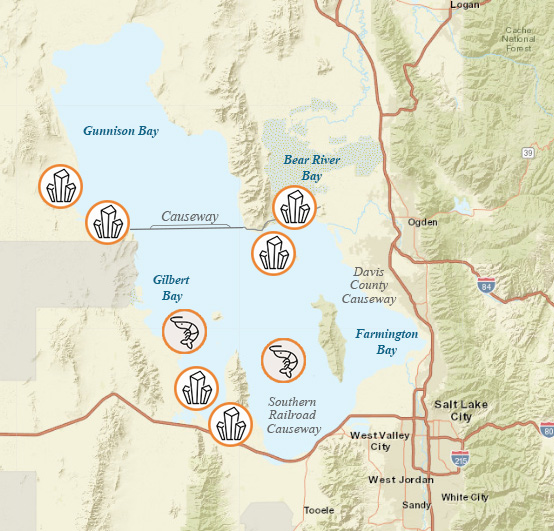Great Salt Lake Hydro Mapper
Great Salt Lake is of high-amenity value to local residents and visitors alike. The area has economically benefitted from the availability of minerals, brine shrimp, and salvaged and remanufactured railroad causeway wood (trestlewood). Tourism and recreation are important contributors to the economic stability of the area; economic benefits are derived not only from direct spending on food, gas, lodging, etc., but also from sales tax generated from visitor spending. In addition to economic resources, GSL also offers a diverse landscape that is often a place of significance for families who have lived in the area for decades, an escape for residents of urban centers and local communities in the region seeking recreation opportunities, and a place that offers unique opportunities for scientific research and environmental preservation.
Changes in lake levels could have an adverse effect on tourism of GSL because resources that area visitors seek (e.g., recreational opportunities such as boating) could be impacted. At a high lake level of 4,212 feet or more, flooding of marinas and the shoreline would occur. This would mainly affect boating activities because access would be reduced. Conversely, boating activities would also be adversely affected by low levels (4,195 feet or less) because motorized boats and most sailboats could remain stranded in the marina. Visitor survey data of the Great Salt Lake Marina from 2010 indicate that at least 20% of the 240,000 annual visitors used the facilities for sailboats and other watercraft activity. A reduction of a minimum of 48,000 visitors annually would result in a loss of revenue and potentially a decrease in the number of jobs needed to sustain such visitor activity.

Approximate locations of brine shrimp harvesting and mineral extraction. Icons surrounded by an orange circle indicate current lake level has an adverse effect.

Typically, brine shrimp populations diminish with decreases in salinity. Although lake levels could drastically affect brine shrimp populations, percentages of brine shrimp that could be harvested at varying lake levels are unknown. By the time salinity affects brine shrimp reproduction at low lake levels, predation is already an issue. At higher salinities, not enough oxygen exists to maintain the survival of the brine shrimp.
Salinity and lake levels also affect nutrients and algal growth. In the harvest year 1997–1998, salinity in the lake allowed brine shrimp to thrive, but nutrients caused diatom blooms that starved the brine shrimp. Higher levels of salinity create difficult conditions for algae to thrive, which affects brine shrimp survival.
Economic impacts due to changes in lake levels would vary for each mineral production company. In general, optimal lake levels for mineral production range between 4,195-4,204 feet. At approximately 4,210 feet or more, flooding could occur, which would force the relocation of structures used for production. Such high lake levels could also damage dikes. The cost of repairing, rebuilding, and reinforcing dike structures can incur a cost of millions of dollars in damage or capital expenditures. Additional ponding areas would also need to be created to make up for the dilution of brines.
At very low lake levels, intake canals to pumps may need to be dredged and/or extended, and the pumps may also be repositioned into deeper water to continue extracting minerals. This would result in an increase in production costs and require additional permits to maintain production activities. At lower levels, between approximately 4,188-4,192 feet, pumping might cease altogether, which would cause business interruption and, consequently, a loss of revenue. The advantage of lower lake levels is that the brine is more concentrated and needs less evaporation time to produce the desired brines and salt.
Information on this page is from the Final Great Salt Lake Comprehensive Management Plan and Record of Decision.